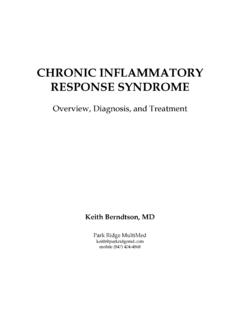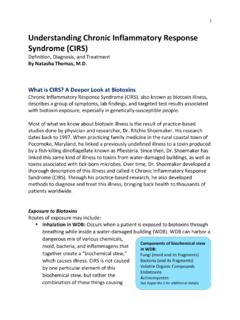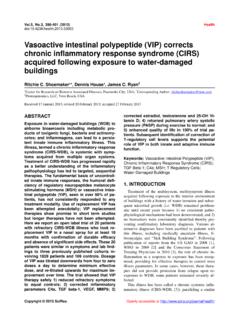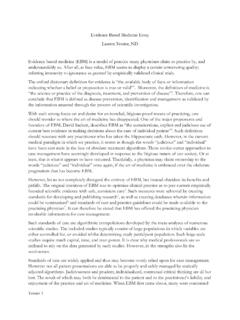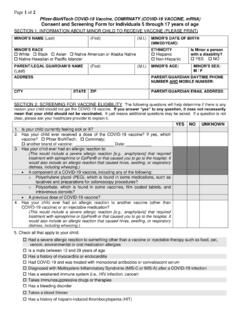Transcription of Steps of the Shoemaker Protocol for treating Chronic ...
1 Steps of the Shoemaker Protocolfor treatingChronic inflammatory Response syndrome acquired following exposure to Water Damaged Buildings [CIRS-WDB]Werner Vosloo NDRestorative Health Clinic is CIRS:The 2009 WHO guidelines for indoor air quality: dampness and mould states that based on studies done in the United States, the prevalence of dampness or mold in houses to be approximately 50%. Inthe United Kingdom, 52% of owner occupied homes had dampness and 24% had mold, while 58% of lower income or rented homes were damp and 56% were moldy. Water damage or humidity high enough to initiate or maintain indoor microbial growth is very common. Chronic inflammatory Response syndrome acquired following exposure to Water Damaged Buildings [CIRS-WDB] is a multi-system, multi-symptom illness mediated by a persistent innate immune inflammatory response to toxins, antigens, and inflammagens present in the interior environment of WDBs.
2 These contaminants include but are not limited to fungi, bacteria, actinomycetes, mycobacteriaand their toxins; as well as inflammagens from fragments of fungal structures. [beta glucans, mannans, hemolysins, proteinases, spirocyclic drimanes and microbial volatile organic compounds (VOCs)]. Many patients acquire CIRS following exposure to a WDB after water intrusion followed by presence of either: 1)visible microbial growth;2)speciation of molds as demonstrated by ERMI or HERTSMI [QPCR DNA] testing; or3)musty biological sources of biotoxins and neurotoxins that are recognized as causes of CIRS include tick borne illnesses including Lyme disease, dinoflagellates like Pfiesteria, blue green algae like Cylindrospermopsis and Microcystis and also , 2, 3, 10, 11, 12, 13 The inflammatory domino cascade:The innate and adaptive immune systems normally function together to remove biotoxins from the body: immune pattern recognition by the innate immune system lead to antibody formation through a complex multi-step process.
3 Antibodies bind to offending substances, leading to their clearance from the body. Clearance of offending biotoxins lead to cessation of innate immune system driven inflammation and not getting sick from biotoxins, like mold particulates and mycotoxins. Genetically susceptible people have a problem with the production of protective antibodies. Offending material left in the body will be detected by the innate immune system in a continuous manner, resulting in a Chronic inflammatory response. This ongoing inflammation leads to recruitment of additional immune inflammatory pathways. The same is true for when there is ongoing exposure. 1 Hypothalamic regulation is significantly affected: cytokines damage leptin receptors which leads to reduced MSH, VIP and ADH production. Hypothalamic dysregulation is linked to many of the problematic symptoms in numerous body ,11,16 Symptoms of CIRS:Differential inflammatory responses dependent on individual genetic susceptibility drives the symptomatic presentation of CIRS.
4 Dr. Shoemaker 's research revealed that CIRS patients can have 13 different clusters of symptoms. Dr. Shoemaker recommends that if a patient has symptoms present in 6 or more of the symptom clusters, biotoxin illness is possible and further testing and evaluation must be done. Symptoms in 8 ormore clusters is consistent with biotoxin illness. The summary diagram below, by Dr. Yvonne Berry MD, represents the 13 symptom clusters identified by Dr Shoemaker through his ,4,112 CIRS Case Criteria: consistent with biotoxin illness. 6 of the symptom clusters listed above is grounds for a thorough diagnostic workup and 8 symptom clusters is consistent with biotoxin illness; consistent with biotoxin exposure to WDB's, toxicogenic blue green algae, tick bites or consumption of reef fish; Contrast Sensitivity (VCS) testing to assess and document capillary hypoperfusion from neurotoxins; predisposition as determined through HLA haplotype; of genomically active MARCoNS in the nasal cavity; abnormal rise in pulmonary arterial systolic hypertension during exercise; consistent with CIRS: neuro-regulatory, neuro-endocrine, neuro-immune, inflammatory , vascular and endocrine Steps of the Shoemaker Protocol for expanded review of biomarkers and their use in helping to correct CIRS.
5 When case criteria are met, proceed with the Shoemaker Protocol . Sequential treatment Steps [see treatment Steps pyramid below] must be followed step by step withoutany changes in sequence or skipping Steps . Dr. Shoemaker recommends repeating a VCS test and checking innate immunity labs after each successive step of the Protocol . (repeat abnormals of the following biomarkers: MMP9, C4a, TGF-B1 and CD4+CD25++T-reg levels).3,4,11,123 Step 1 Remove from exposure and decrease ERMI below 2. Normal range: ERMI <2 or HERTSMI 2 <10 Objective remove from source of inflammagen exposureRemoval from the perceived major eliciting and maintaining cause of Chronic inflammatory illness is the single most important and first step in treating CIRS-WDB and other biotoxin illness. Testing for exposure is most accurately and economically done with the Environmental Relative Mold Index ERMI test through Four to six weeks after the completion of mold remediation work, Dr.
6 Shoemaker advises either repeating an ERMI or doing a HERTSMI-2 test. ERMI or HERTSMI-2 documents fungal DNA in patients environment through quantitative surface dustPCR analysis. Fungal DNA in surface dust is used as an indicator of what was present in the air at an earlier time. The EPA released the ERMI test in 2006. Fungal fragments and spores that were in the air and then settled in dust are relevant in the causation of CIRS, establishing that CIRS is more than a mold or biotoxin : When C4a is below 20,000 and MSH is less than 35 the building ERMI score must be below 2. When C4a exceeds 20,000 and MSH is below 35 the ERMI needs to be -1 to improve the response to treatment due to lower exogenous exposure. 4 Step 2 Binders: CSM / WelcholNormal range: VCS passedObjective: Reduce circulating biotoxin burdenCholestyramine is a cholesterol lowering medicine that binds an ammonium side chain to anion ring formations of biotoxin molecules in the small intestine and decreases the amount of bile plus biotoxins reabsorbed back into the bloodstream from the small intestine.
7 Approximately 95% of bile [in which many biotoxins are released] is reabsorbed in the lower small intestine, making our bodies VERY ineffective at eliminating small molecular size biotoxins. Only 5% of bile and thus likely biotoxins exit the body through stool with each go-around. This means that in the 24% of CIRS susceptible people, the reabsorption and recirculation of bile plus biotoxins will be cause for a sustained inflammatory safety and simplicity of Step 2 is genius sequester and remove inflammagens with a resin or glue like substance and reduce inflammatory recruitment. Interruption of bile reabsorption 4 times per day yields better results in active treatment phases, thus 4doses of bile binders per day is mandatory for satisfactory results. Cholestyramine is a very effective bile binder. It must be taken on an empty stomach esp away from prescription medicines.
8 Four doses on an empty stomach may be a challenge if someone is already on a demanding dosing schedule. Alternatively taking only 2 doses of CSM on an empty stomach and 2 doses of Welchol 2 tablets per dose with two meals enables 4 opportunities to bind biotoxins in a more manageable manner. Cholestyramine doses should ideally be 4 grams per dose, Welchol 625mg tablets. For sensitive patients, compounded CSM is available from compounding pharmacies in both powder and capsule form. Side effects include heartburn / reflux and constipation which can be counteracted with salts of magnesium without compromising the binding capacity of CSM. It is essential to manage GI transit to avoid constipation. Starting with smaller doses and increasing dose size and frequency as your body demonstrates tolerance is advised in certain select patients [Lyme disease with elevated MMP9 and patients with ongoing mold and biotoxin exposure] biotoxin binding may cause a systemic inflammatory flare with exacerbation of symptoms.
9 This can be attenuated with pre-treatment for 5 or more days with the low amylose diet and high dose fish oil [enteric coated by preference] consisting of grams EPA and grams EPA per day, with meals. Actos is more effective, but used only if fish oil is not effective enough. Due to the leptin lowering effectof Actos, high dose Omega-3 fatty acids are preferred over Actos in patients with leptin < 7. Actos has a bladder cancer black box warning. Monitoring guidelines includes baseline and follow up liver function measurement: The VCS test is an objective measurement to track the effect of binders doses of binders may be decreased once the VCS is passed and patient is in a safe environment. 5 Step 3 Eradicating MARCoNS with BEG nasal sprayNormal range: no MARCoNS presentObjective: Remove biofilm dwelling resistant staphylococci that keep MSH lowWhen MSH is low, MARCoNS are present in more than 80% of cases.
10 Less than 2% of patients with normal MSH has MARCoNS present. Diagnostic screening API Staph nasal swab is indicated in all cases with low MSH. In patients under 15 yo this can be done at clinicians judgement, due to there being a lesser MARCoNS incidence. Low MSH, with resultant decrease in mucosal immune function appears to be correlated with the presence of MARCoNS. When present, MARCoNS secrete exotoxins A and B from biofilm communities which shelters microbes against body defenses and antibiotics. One month after starting bile binding therapy, one can start with BEG nasal spray [Bactroban (Mupirocin) , Edetate Disodium (EDTA) 1%,Gentamicin ] 2 sprays per nostril three times perday. Lidocaine nasal spray may be used prior to BEG spray doses to reduce treatment discomfort. Discomfort from the spray, nosebleeds, swelling and congestion resembling sinusitis may be experienced during MARCoNS eradication treatment with BEG nasal spray.
